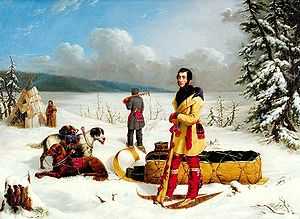Capote (garment)

A capote or capot (/ka.pɔt/) is a long coat with a hood.
From the early days of the North American fur trade, both natives and French Canadian voyageurs made wool blankets into capotes, which were perfectly suited to Canada's cold winters.[1] They served as winter outerwear for the habitants and voyageurs of New France and the Métis of the Red River Colony.
The Hudson’s Bay Company also sold capotes, called blanket coats or Hudson Bay coats, made out of Hudson's Bay point blankets.[2]
Habitant capote
In the early 1600s French sailors traded their capotes to the Micmac in North America and by 1619 the French habitants were also wearing capotes. Fifty years later the habitants wore an altered form of the capote possibly based on the then fashionable justacorps or on the French military uniforms of soldiers stationed in New France at the time such as the Carignan-Salières Regiment. The altered knee length version had no buttons and was worn with a military sash (Ceinture fléchée).[2][3] The habitant capot was no longer the sailors' capot nor the soldiers' capote but something distinct combining features from both.[4]
Capot is the Quebec French word that described this unique winter jacket. From capot came the verb encapoter or s'encapoter also in Quebec French (meaning to put on a capot and other winter accessories before going out).[4]
Métis capote
"The Metis man’s winter attire was the capote; a thigh length coat with full length sleeves which could come with or without a hood or cape. Most had small shoulder decorations made of red stroud. To keep the coat closed there were both thongs and buttons or a sash." Lawrence J. Barkwell[5]
The Métis capote of the Red River area were made of leather or wool.[5] Those made of leather were often decorated with beads and silk embroidery in floral designs.[6] The wool capotes were of different colors; blue was preferred by the Catholic Métis and white by the Protestant Métis while grey was worn by both.[5] A sash was worn around the waist and a fire bag was either tucked in the folds of the sash or hung around the neck by a shoulder strap. A fire bag was used for carrying flints, steel and tinder to start a fire as well as tobacco, pipe, knife and other personal items[7] as most capotes had no pockets.
William H. Keating described a group of Métis buffalo hunters he encountered at Pembina by the Red River in 1823.
"All of them have a blue capote with a hood, which they use only in bad weather; the capote is secured round their waist by a military sash; they wear a shirt of calico or painted muslin, moccassins and leather leggings fastened round the leg by garters ornamented with beads,&c. The Bois brulés often dispense with a hat; when they have one, it is generally variegated in the Indian manner, with feathers, gilt lace, and other tawdry ornaments." (William Keating 1824)[8]
In Canadian culture
In the latter half of the 19th century the blanket coat was popularized amongst the European descended population of Canada to the extent that it was looked on as national dress. Blanket coats had been used for some time before by those with outdoor occupations, but in this period the cut and construction of the coat started to follow changing European and American fashions and became more widely used.[9]
The popularity of the coat was part of a wider movement to adopt aspects of the culture of indigenous people in order to establish a Canadian identity that was separate from both British and United States identities.[10] Two elite groups were important in establishing the blanket coat's popularity. One was the Montreal Snow Shoe Club which adopted the blanket coat as required equipment.[11] Snow shoeing was another activity adopted from indigenous people and for a time became immensely popular as a sport. The other group was a succession of Governors General of Canada photographed wearing blanket coats. Perhaps even more significant for spreading the coat as a fashion was its wearing by the wives of Governors General. Initially considered a male garment, by this period it was being made in versions for women and children.[12]
Gallery
-
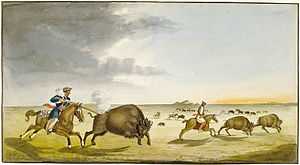
Métis in capotes hunting buffalo in the Red River area (1822)
-

Hurons de la Jeune Lorette, Québec, Canada c. 1838. Blue trimmed white capote and sash
-
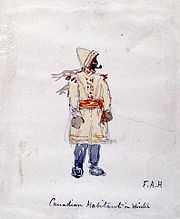
Habitant in winter dress, by Frances Anne Hopkins (1858)
-

Members of the Montreal Snow Shoe Club in 1877 in capotes and sashes
-
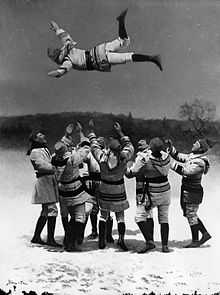
Members of the Montreal Snow Shoe Club in 1886 in capotes and sashes
-
Capote for scout on raiding party, Siksika, early 1900s, wool from Hudson's Bay Company blanket
-
_on_white_horse._3.jpg)
William Jackson (Little Blackfeet) on white horse, Siksika (Blackfoot), Montana. c. 1900s.
-
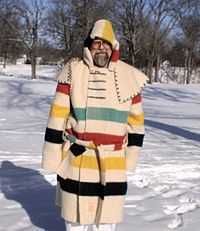
Traditional capote made with a Hudson's Bay point blanket
References
- ↑ "the native canadian". Nativecanadian.ca. Retrieved October 19, 2013.
- ↑ 2.0 2.1 "Capots (Art. III. Capots, with some Side Lights on Chiefs' Coats & Blankets, 1774-1821, by A. Gottfred.)". Northwest Journal Online. Retrieved 2014-01-29.
- ↑ "Rocky Mountain House National Historic Site of Canada (The Capote)". Parks Canada. Retrieved 2014-01-29.
- ↑ 4.0 4.1 Déliberations Et Mémoires de la Société Royale Du Canada. Royal Society of Canada. 1885. p. 21. Retrieved 2014-04-10.
- ↑ 5.0 5.1 5.2 5.3 "Metis Culture: A pictorial essay on the Metis capote". Laurence J. Barkwell. Retrieved 2014-01-30.
- ↑ "Floral Beadwork: A Métis Cultural Heritage to Rediscover". Encyclopedia of French Cultural Heritage in North America. Retrieved 2014-02-05.
- ↑ "Royal Alberta Museum Online Exhibitions: A Métis Fire Bag". Retrieved 2014-01-30.
- ↑ William Hypolitus Keating (1824). Narrative of an expedition to the source of St. Peter's river ... &c., performed in ... 1823. p. 44. Retrieved 2014-04-10.
- ↑ Eileen Stack (2004). "Very picturesque and very Canadian: the blanket coat and Anglo-Canadian identity in the second half of the nineteenth century", in "Fashion--A Canadian Perspective" edited by Alexandra Palmer. University of Toronto Press. pp. 17–18. ISBN 978-0-8020-8590-0.
- ↑ Stack, p. 33
- ↑ Stack, p. 18
- ↑ Stack, p. 21
External links
| Wikimedia Commons has media related to Capote (garment). |
| Look up capote in Wiktionary, the free dictionary. |
- Compagnies franches de la Marine winter dress between 1690 and 1700
- Metis textiles
- Metis capote (without a hood)
- Portrait of Robert Kennicott in 1862 wearing a Metis/voyageur outfit (see image 4) (In this Carte de visite Robert Kennicott is wearing a double breasted capote with buttons tied at the waist with a metis sash with a marten fur fire-bag tucked in. His pants are trimmed with ribbon on the outside seams and on the cuffs. The pants are tied just below the knees with garters ending in tassels and on his feet are beaded or embroidered moccasins. On his head is a toque.)
